The Human-Powered Adventures of Ultra Runner Sarah Keyes
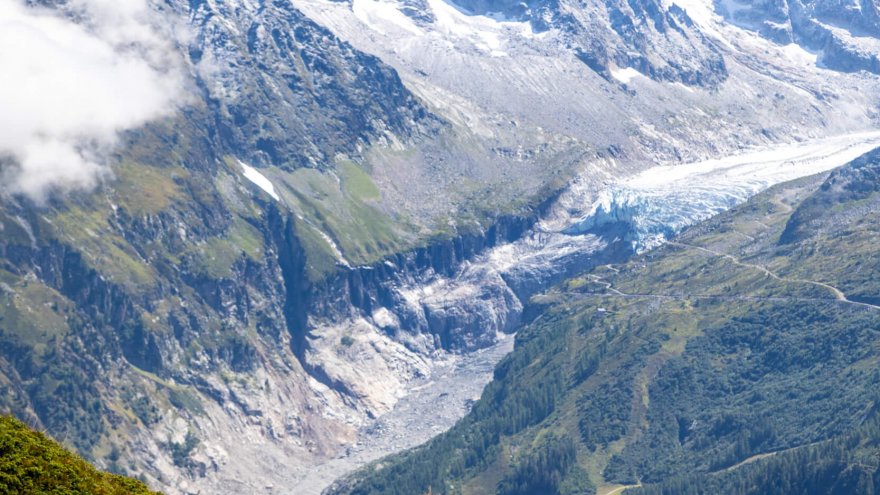
On a cool July evening in 2014, I was having a drink at the Lake Placid Pub & Brewery after biking 100 miles and eavesdropping on a conversation between one of the servers and several other patrons. The server had just returned from the Wakely Dam Ultra, a 32.6-mile race in Piseco, NY, where she was the first place female and sixth place overall! I was intrigued and joined the conversation. Sarah Keyes was the first ultrarunner I had ever met in person. Wakely Dam was her first ultra, and she has been racking up the miles and medals ever since!
I recently had the chance to catch up with Sarah on all her latest running adventures, big plans for 2019, and the importance of human-powered time outside.
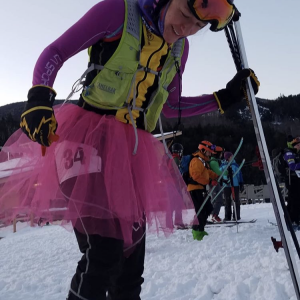
You tweaked your hamstring over the holidays and embraced the minor injury as “a fantastic opportunity.” How can other injured runners see injury as an opportunity rather than an obstacle?
What in the moment was a mini-crisis quickly became a fantastic opportunity. No one wants to be sidelined with an injury, but the best thing to do is take time off right away instead of pushing through the injury and making it worse. I suggest cross training and strength training while recovering from an injury. Tweaking my hamstring got me back in the gym. I reconnected with the community there, which turned into an opportunity for me to coach for the gym! I’m excited to have the chance to give back to the Lake Placid community as the trail running coach. It’s fun to encourage other people who might be trying their first trail race, or want to switch from road racing and triathlon to trail running. And tweaking my hamstring set the whole thing in motion!
What do you do for a living, and how do you balance life and ultra running?
Routine is important to maintaining that balance between running and life. I am a nurse part-time, working 12-hour shifts a few days a week. I look at all that time being on my feet as good endurance training! I also work at a running store in town part-time. I spend the rest of my time coaching, training, and racing. I make time to run because running is my meditation.
To get my training in, I get up at 4 am every day and run before work. Consistency is key! My schedule is different every week, so I have to be flexible. To balance ultra running and life takes commitment! You have to be dedicated to finding time for running, even if it’s 3 miles here and 4 miles there. A few miles is better than no miles, and over the course of the week, it adds up, putting enough stress on your joints to build up those adaptations that are necessary to prepare your body for an ultra.
Keep it fun too! I already have a few jobs, so running shouldn’t feel like another job. When it starts to, the ultra community always draws me back in and makes it enjoyable again. Traveling to new places to race also keeps the fun in running. And when the balancing act gets tough, the trail running community is always there for me!
Tell us about your favorite training partner, Mocha Pebbles!
Mocha Pebbles is my rescue dog! She is a 20-pound Aussie-spaniel mix from Kentucky, and she does all my road running with me! I also take her into the woods and let her run around. Honestly, I take her along for almost all of my workouts, from fast training to recovery days. She’s even done 30 miles on the mountain with me. When I watch how she bounces along out there, I remember that running is supposed to be fun!
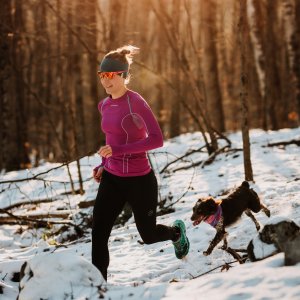
There seems to be a stigma around the dreaded DNF. You had your first one in Ultra-Trail Du Mont-Blanc – UTMB – Chamonix, France last year. Do you have any encouragement for runners who might be beating themselves up over a recent DNF?
Last year’s race was definitely interesting! It starts at 6 pm on August 31st and goes into most of the next day, and possibly the third day. The race cut-off is 48 hours.
I went to Chamonix a whole two weeks ahead of time to acclimate. In the days leading up to the race, I ran up over the passes. They weren’t really that high, but for some reason, I woke up with vertigo, so I tried to correct it with movement. I was there just to run it because this course is so amazing! So I started the race, and was out there enjoying the full moon and the glaciers, and was able to stay in 5th to 10th place most of the time.
When I was climbing out of Courmayeur, my head started spinning. I thought maybe I was dehydrated so I sat down. Then the sun came up and it was so bright that it made my head feel worse. At 100k, I was going to drop out. The doctor thought I was just suffering from dehydration. There was definitely a language barrier there, but after speaking to him, I laid in the heated medical trailer (it snowed overnight, and temperatures dropped into the teens, making it necessary to heat the trailer). The doctor gave me anti-nausea medication, and I got back out there, even though the meds and hydration did nothing to make my head feel better. I knew my family was waiting for me over the high point of the course, Grand Col Ferret, so I climbed over that point. By the time I reached them, it was the end for me.
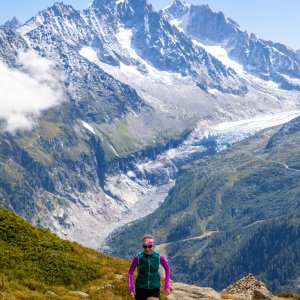
Going into UTMB – Chamonix, I felt good and felt confident about my training. Until my head started spinning I was racing really well too! It was my first DNF, but it was still an amazing experience! There were so many big-name ultra runners there to race, and there were helicopters flying along the course, filming us. Spectators lined the course, even in the middle of the night. I could have walked in the last 30 miles, but I wasn’t there to walk. Finishing while suffering from vertigo would have been the wrong choice!
I say it is time to put the “dignity” back in “did not finish.” Sometimes it is so much smarter to DNF. Think about it… You could really hurt yourself if you keep pushing through illness or injury. It is much wiser to stop, and be proud that you put in a good effort! Failure is a learning experience. You learn you can’t always win, in life and in running.
Trust me, it’s not easy to go all the way to France and be more than halfway through your big race, and realize that it’s not safe to go on. You may feel like you failed, and that’s OK! Let that fuel you in the future. For me, that means going back to UTMB – Chamonix this summer!
You’ve mentioned that there are some big things coming in 2019! Can you tell RunnerClick a little more about your plans for this year?
After doing the 37-mile California Riding and Hiking Trail, or Joshua Tree Traverse, through Joshua Tree National Park this past December, and getting the women’s record of 5hr 17min 15sec, I plan to do the Zion Traverse this year, and attempt to break the women’s record and attain the fastest known time (FKT). I tried that in 2017 and I tapped the trailhead sign at 8hr 27min 36sec, a mere 67 seconds slower than Joelle Vaught’s record. Then when I attempted to return to Zion last year for the renowned 50-mile crossing of Zion National Park, it snowed, so that didn’t happen.
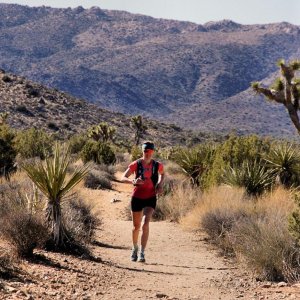
I’m training for the Georgia Death Race, a point-to-point ultra-marathon in the mountains of North Georgia, in March. The race is approximately 70 miles with nearly 28,000 feet of elevation change, and it’s a Golden Ticket race for the Western States. I finished the Western States in 2017, but I walked it in. For the first 15 miles of Western States, I was running on snow. As the day went on, the temperature climbed to 105 degrees! The snow melted, my feet were soaked, and I had blisters on every single toe. I was at an aid station, crying and considering dropping out of the race when Maggie Guterl came through. She was also having a bad day. She saw me at the aid station and said “Come on! We’re all going to finish!” and that got me back on my feet again. We had to cut my shoes open so I could go on, and there was a lot of walking, but we finished. I am highly motivated to get back to that race and finish strong this time!
A lot of people head indoors and hop on the treadmill when the temperatures drop. What do you think of treadmill training?
There’s a place for it! For me, below 10 degrees is treadmill weather. Those temperatures are not always good for your throat. Breathing in the cold air can be bad for your larynx. And the closer you get to zero degrees, the more toll the cold can take on your joints. If I do run outside when it’s that cold, I make sure to dress right and keep moving along. You want your clothing to be protective, but not restrictive. Wool is wonderful because it’s light. Dermatone Skin Protector is also great for wind and sun protection.

Once a week, I put special bindings on my skis to skin, or ski uphill. I skin up Whiteface Mountain, the fifth-highest mountain in New York state, which has a vertical drop of 3,430 feet. I get up there before the sun comes up for a good low-impact workout. Skinning is excellent training for all the mountain climbing and power hiking I do in ultra racing. I also recommend backcountry skiing, cross-country skiing, and snowshoeing when it’s too cold and icy to run. Despite the winter weather, there are ways we can and should make a habit of spending more human-powered time outside in 2019!
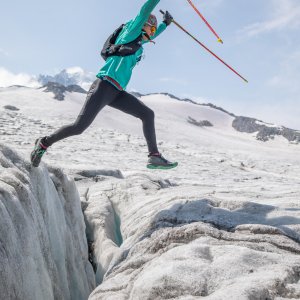
Want to keep up with Sarah Keyes and her human-powered adventures? You can find her on Facebook as Sarah Keyes, on Instagram @sarahkeyes_runs, and on her website, www.sarahruns.com
Sources
- ,
Latest Articles
 Is Running on a Treadmill Easier Than Running Outside?Runners have their own preferences, whether it is treadmill running, running outside on the road, or exploring trails. So...
Is Running on a Treadmill Easier Than Running Outside?Runners have their own preferences, whether it is treadmill running, running outside on the road, or exploring trails. So... Is It OK to Use Trail Running Shoes on the Road?While trail running shoes can be used on roads, especially in situations where a runner encounters mixed terrains or pref...
Is It OK to Use Trail Running Shoes on the Road?While trail running shoes can be used on roads, especially in situations where a runner encounters mixed terrains or pref... How to Fix Sore Quads After Running?Rest, ice, gentle stretching, and over-the-counter pain relievers can help soothe sore quads after running. Also, ensure ...
How to Fix Sore Quads After Running?Rest, ice, gentle stretching, and over-the-counter pain relievers can help soothe sore quads after running. Also, ensure ... 10 Fruits With The Most Electrolytes to Replace Sports DrinksThese fruits are high in electrolytes such as potassium, magnesium, and calcium, essential for hydration, muscle function...
10 Fruits With The Most Electrolytes to Replace Sports DrinksThese fruits are high in electrolytes such as potassium, magnesium, and calcium, essential for hydration, muscle function...

